2. 中国地质科学院地质研究所, 北京 100037
2. Institute of Geology, China Academy of Geological Sciences, Beijing 100037, China
华北克拉通作为世界上最古老的克拉通之一,其早期的基底物质组成、地壳演化及克拉通化的时代一直是中国早前寒武纪研究的重要内容。目前,比较一致的观点认为,华北克拉通是通过几个陆块的拼合,并于古元古代吕梁运动之后完成了最终克拉通化(伍家善等,1998;Zhai and Santosh, 2011;Zhao et al., 2010;Zhao and Zhai, 2012)。但是,目前对于华北克拉通基底拼合的时间和过程还存在不同认识,主要有以下3种不同观点和模式:(1) 较传统的观点认为,华北克拉通由五个或七个微陆块组成(伍家善等,1998;Zhai and Santosh, 2011),这些微陆块在~2.5Ga通过弧-陆或陆-陆碰撞汇聚在一起,形成初步的克拉通。之后经历了古元古代裂谷、俯冲-碰撞过程于1.82Ga最终完成华北克拉通化(Zhai and Santosh, 2011);(2) 另外一些学者将华北克拉通划分为东部陆块、西部陆块和中部造山带。东部陆块向西部陆块俯冲,并沿着中部造山带于太古宙末期(~2.5Ga)发生碰撞拼合(李江海等, 2000, 2004, 2006;Kusky and Li, 2003;Kusky et al., 2007);(3) Zhao et al.(1998, 1999, 2000a, b, 2001a, b, 2002, 2005, 2008a, 2010)将华北克拉通基底划分为东部陆块、西部陆块和中部带,新太古代末期西部陆块开始向东部俯冲,并在1.85~1.80Ga通过中部带把两个陆块连接在一起,形成完整的华北克拉通。近年来,中部带(或中部造山带)的古元古代演化成为研究的重点内容,一些学者提出了2.1Ga和1.8Ga两阶段的俯冲碰撞模式(Lin et al., 2007;Wang et al., 2010;Trap et al., 2009a, 2012)。上述研究中,中部带的地质过程对探究华北克拉通化过程具有重要作用。因此,选择华北克拉通中部带基底杂岩进行研究,对重塑华北早期地质演化历史和克拉通化过程具有重要意义。
A型花岗岩最初是由Loiselle and Wones (1979)提出,用来定义一种特殊的花岗岩类型,即碱性(alkaline)、无水(anhydrous)、非造山(anorogenic)。与I、S和M型花岗岩分类和特定源岩有密切的联系不同,A型花岗岩的岩浆源区存在多样性,如幔源(Loiselle and Wones, 1979;Turner et al., 1992;Litvinovsky et al., 2002;Mushkin et al., 2003)、壳源(Collins et al., 1982;White and Chappell, 1983; Clemens et al., 1986;Whalen et al., 1987;King et al., 1997;Anderson, 1983; Creaser et al., 1991;Skjerlie and Johnson, 1992;Patiño Douce, 1997)和壳幔混合源(Bédard, 1990;Kerr and Fryer, 1993;Mingram et al., 2000;Yang et al., 2006)。目前,A型花岗岩已经涵盖除典型的S型和I型以外的所有花岗岩类型(许保良等, 1998)。比较公认的一种观点是A型花岗岩形成于板内或碰撞后伸展的构造环境中(Whalen et al., 1987)。该类花岗岩在古元古代晚期-中元古代(1.9~1.0Ga)曾大量出现,而太古宙具有A型特征的花岗岩仅局限于新太古代(Feio et al., 2012)。在华北克拉通,中生代的A型花岗岩在中国东北地区分布较广泛(Wu et al., 2002),同时~1.7Ga (杨进辉等,2005)和古元古代2.2~2.0Ga (路孝平等, 2004a, b;Du et al., 2013, 2016a及其中文献)的A型花岗岩也在一些地区陆续发现,而太古宙的A型花岗岩仅在赞皇地区有报道(Wang et al., 2015)。本文在详细野外工作基础上,通过岩石学、地球化学、锆石U-Pb年代学和Hf同位素研究,对华北克拉通中部赞皇地区黄岔A型花岗岩进行了详细的研究,探讨该花岗岩的成因及构造环境;结合区域岩石组合和年代学资料,认为华北克拉通在新太古代末可能初步完成克拉通化。
1 区域地质背景赞皇杂岩出露于华北克拉通中部带中段东侧,北侧紧邻阜平杂岩,东西宽40~60km,南北长约140km,总面积约3850km2,总体呈“纺锤形”的NNE-SSW向展布(牛树银等, 1994a)(图 1a, b)。主要包括新太古代的TTG片麻岩,钾质-二长片麻岩,新太古代赞皇群、新太古代-古元古代官都群、古元古代甘陶河群和花岗岩(河北省地质矿产局, 1989;杨崇辉等, 2011a, b;Yang et al., 2013)。近年来,前人对该杂岩陆续进行了相关研究(河北省地质矿产局, 1989;雷世和等, 1994;牛树银等, 1994a, b;Wang et al., 2003, 2004, 2013, 2015, 2017;王岳军等, 2003; Trap et al., 2009a, b;Xiao et al., 2011, 2014;肖玲玲和王国栋, 2011;杨崇辉等, 2011a, b;肖玲玲等, 2012, 2013;Deng et al., 2013;Yang et al., 2013; Kusky et al., 2015;Du et al., 2016a, b;Li et al., 2016;Tang et al., 2016)。其中,新太古代TTG片麻岩主要为~2.7Ga的英云闪长质片麻岩(Yang et al., 2013)和2.55~2.50Ga的英云闪长质到花岗闪长质片麻岩(杨崇辉等, 2011b, 2015),这些片麻岩被认为是俯冲背景下的板片熔融形成的(杨崇辉等, 2011b, 2015;Yang et al., 2013);而赞皇杂岩中的钾质-二长花岗质片麻岩则指示同碰撞或后碰撞构造环境(杨崇辉等, 2011b, 2015;Wang et al., 2015);赞皇群地层呈残片状分布于TTG片麻岩中,为一套中高级的变质岩系,主要分布于邢台市皇寺镇以西、内丘县獐獏乡西及赞皇县黄北坪-临城县院头一带,由黑云斜长片麻岩、斜长角闪岩、(含)石榴蓝晶斜长片麻岩为主的变泥质岩组成(Xiao et al., 2011)。官都群地层层状特征明显,呈NE-SW狭长的带状分布于赞皇杂岩的中部,主要包括斜长角闪岩,大理岩,石英岩及少量变泥质岩,遭受18亿年左右的角闪岩相变质作用(Trap et al., 2009b;Xiao et al., 2014);古元古代的甘陶河群出露于赞皇杂岩西北部,沿甘陶河流域两侧近南北向的带状分布,在元氏县西部上寨至井陉南部吴家窑一带也有出露。其主要的岩石组合为变质砂岩和变质玄武岩,部分层位夹有板岩,局部有少量碳酸盐岩,普遍遭受了绿片岩相变质,局部变质程度达低角闪岩相(河北省地质矿产局, 1989;Liu et al., 2012;Xie et al., 2012;杨崇辉等, 2015;Du et al., 2016b)。通过变质火山岩和变质砂岩中锆石U-Pb年龄结果,甘陶河群的时代被限定为2.1~1.9Ga (Liu et al., 2012;Xie et al., 2012;Du et al., 2016b)。

|
图 1 赞皇地区构造位置(a, 据Trap et al., 2009b)和地质简图(b, 据Du et al., 2016a) Fig. 1 Geological sketch map of the Zanhuang Complex (a, after Trap et al., 2009b; b, after Du et al., 2016a) |
在赞皇杂岩中,作为重要地质单元之一的官都群时代还没有准确的限定。早期划为太古宙赞皇群,1:5万临城幅等区域地质调查报告认为其不整合于新太古代片麻岩之上(河北省地质矿产局第十一地质大队, 1989①, 1993②),同时测得官都群下部含磁铁矿条带白云母石英片岩Rb-Sr全岩年龄为2061±148Ma (河北省地质矿产局第十一地质大队, 1996③),认为是变质年龄,而侵入官都群的黄岔岩体的锆石U-Pb一致线年龄为2210Ma (河北省地质矿产局第十一地质大队, 1993),因而限定的官都群的形成时代为早元古代。但王启超等(2008)认为该侵入岩体的测试年龄误差较大,不能反映官都群的形成年龄时限。而通过古元古代的甘陶河群与五台地区的滹沱群对比,认为下伏的官都群应划为新太古代。由于官都群主要以变质基性火山岩和碎屑沉积岩为主,缺乏可供测年的变质中酸性火山岩,因此获得准确时代存在困难。本文通过侵入其中花岗岩的时代来限定官都群的时代;同时,赞皇地区新近厘定的新太古代黄岔岩体具有A型花岗岩特征,对其进一步深入的研究,为华北克拉通新太古代拼合提供了有力的证据。
① 河北省地质矿产局第十一地质大队.1989. 1:5万测鱼幅、王家坪幅、摩天岭幅区域地质调查报告
② 河北省地质矿产局第十一地质大队.1993. 1:5万北褚幅、赞皇幅、临城幅地质图及说明书
③ 河北省地质矿产局第十一地质大队.1996. 1:5万将军墓幅、西丘幅、西黄村幅、邢台市幅地质图及说明书
2 黄岔岩体的岩相学特征黄岔岩体位于河北省邢台市北西王家庄村-黄岔村一带,呈不规则状的岩株产出,面积约12km2(图 2)。该岩体呈高大陡峻的山体,具典型的花岗岩外貌特征(图 3a)。岩体的北部和南部与官都群的石英岩为韧性剪切构造接触关系,局部可见花岗岩侵入并包裹石英岩(图 3b),表明黄岔岩体和官都群原来应为侵入接触关系。岩体片麻理与围岩石英岩片理产状一致,宏观上岩体由北西向南东推覆压盖在地层之上(图 3c)。黄岔岩体风化面浅黄褐色,新鲜面浅粉色-灰白色,岩性较均匀,表现为典型的侵入岩特征,岩体边部可见少量细粒黑云斜长片麻岩(黑云变粒岩)包体(图 3d)。岩石主体为片麻状、块状构造,似斑状结构,在岩体边缘可见强烈糜棱岩化(图 3e)。岩体成分较均匀,以似斑状黑云二长花岗岩为主,斑晶为半自形-自形钾长石,偶见石英,多为0.5×1.0cm,个别1.0×1.5cm,斑晶含量5%~10%,基质为中粒花岗结构,局部斑晶不发育,为黑云二长花岗岩,可见伟晶岩脉穿插。

|
图 2 黄岔岩体构造位置图(据河北省地质矿产局第十一地质大队,1996修编) Fig. 2 Geological sketch map of Huangcha granite |
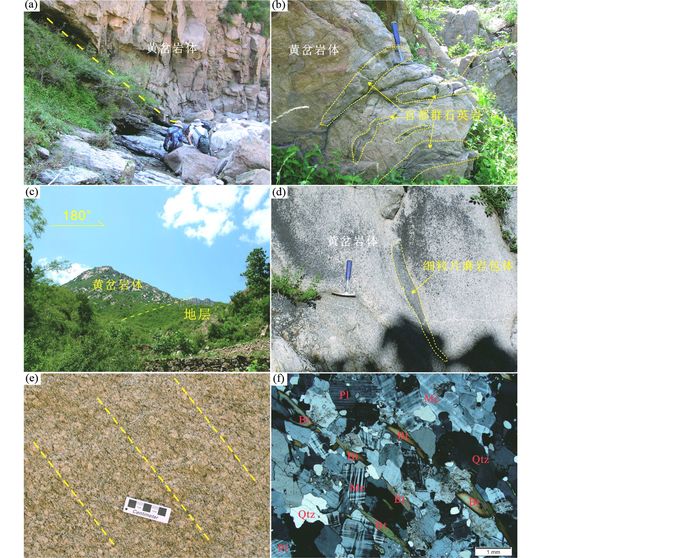
|
图 3 黄岔岩体的野外及显微照片 (a)黄岔岩体野外特征;(b)黄岔岩体与官都群石英岩的接触关系;(c)黄岔岩体推覆压盖于地层之上; (d)岩体中的细粒片麻岩包体;(e)似斑状、片麻状构造;(f)黄岔岩体矿物组成,其中黑云母定向形成片麻理.矿物缩写代号见沈其韩(2009) Fig. 3 Field photos and photomicrographs under microscope of the Huangcha granite in the Zanhuang Complex (a) field features of Huangcha granite; (b) contact between Huangcha granite and Paleoproterozoic quartzite; (c) tectonic between Huangcha granite and Guandu Group; (d) fine grained gneiss inclusions in the Huangcha granite; (e) foliation in the Huangcha granite; (f) mineral composition of the Huangcha granite, lineation defined by orientation of elongated biotite. Mineral abbreviations after Shen (2009) |
本次工作从岩体的内部向南侧边部依次采取了5块新鲜样品进行研究,采样位置见图 2。Z119-1为中粒片麻状黑云二长花岗岩:中粒不等粒花岗结构,偶见长石斑晶,暗色矿物主要为黑云母(5%),未见白云母。Z119-2和Z119-3岩性基本相同,为中粒强片麻状似斑状黑云二长花岗岩:黑云母定向不连续构成片麻理,长石绢云母化较强烈,含少量白云母(1%~2%)。Z119-4和Z119-9岩性基本相同,为细中粒片麻状似斑状黑云二长花岗岩:片麻理较弱,斑晶为半自形-自形长石和少量他形石英,长石发生弱绢云母化,暗色矿物含量较少(7%),分布较均匀,主要为黑云母。
镜下观察基质主要由石英(25%~30%)、微斜长石(30%~35%)、斜长石(15%~20%)、黑云母(5%~10%)和少量白云母、绿泥石、绿帘石和锆石、榍石等副矿物组成。暗色矿物黑云母、绿泥石、绿帘石和不透明矿物(磁铁矿)等分布不均匀,常聚集成团块状,黑云母定向排列(图 3f)。石英呈他形粒状,粒度多为0.2~1.5mm,常以集合体形式存在,波状消光明显,可见交代穿孔现象。微斜长石呈他形粒状,少量半自形板状,发育宽大的格子双晶,粒度多为0.5~2mm之间。斜长石多为他形-半自形板状,粒度与微斜长石基本一致,主要为钠长石,聚片双晶发育,并可见卡钠复合双晶,绢云母化较强烈。黑云母细小鳞片状,绿泥石化和绿帘石化强烈,具有定向性。
3 分析方法全岩主量、微量和稀土元素含量由北京国家地质测试分析中心测试,其中全岩主量元素用X荧光光谱仪(XRF)分析,所用仪器为日本理学3080E,误差 < 0.5%;微量元素和稀土元素采用等离子质谱仪分析,误差 < 5%。
锆石测年在天津地质矿产研究所同位素实验室利用激光烧蚀多接收器等离子质谱仪(LA-MC-ICPMS)进行微区原位U-Pb同位素测定。分析仪器为Thermo Fisher公司制造的Neptune多接收器等离子质谱仪,与等离子质谱仪配套的进样设备激光器为美国ESI公司生产的UP193-FX ArF准分子激光器,激光波长193nm,脉冲宽度5ns,本次测试所用束斑为35μm。根据锆石阴极荧光照片、显微镜下反射光和透射光照片选择锆石合适的年龄晶域,对锆石进行剥蚀。采用TEMORA和GJ-1作为外部锆石年龄标准进行U、Pb同位素分馏校正(Black et al., 2003;Jackson et al., 2004)。采用Ludwig的Isoplot程序(Ludwig, 2001)进行数据处理,采用208Pb校正法对普通铅进行校正(Andersen, 2002)。利用NIST612玻璃标样作为外标计算锆石样品的Pb、U、Th含量。LA-MC-ICPMS年龄测定试验条件和关键参数:接收器设置——L4,206Pb;L3,207Pb;L2,208Pb;C,219.26;H2,232Th;H4, 238U。冷却气体16L·min-1,辅助气体0.75L·min-1,Ar载气0.968L·min-1,He载气0.86L·min-1。RF功率1251W,积分时间0.131s,样品信号采集时间60s (其中20s为空白的测定),详细测试流程见李怀坤等(2009)。
锆石Hf同位素分析采用与U-Pb测年同一实验室相同仪器在已进行了定年的同点或同域锆石上进行。分析方法见耿建珍等(2011)。采用静态信号采集模式,背景采集时间为30s,积分时间为0.131s,采集200组数据,总计约0.5min。激光能量密度为10~11J/cm2, 频率为8~10Hz,束斑直径为55μm。采用176Hf/177/Hf=0.7325(Patchett and Tatsumoto, 1981)对Hf同位素比值进行指数归一化质量歧视校正,采用173Yb/172Yb=1.35274(Chu et al., 2002)对Yb同位素比值进行指数归一化质量歧视校正。在εHf(t)计算时,球粒陨石的176Hf/177Hf比值为0.282772,176Lu/177Hf比值为0.0332(Blichert-Toft and Albarède,1997)。在单阶段Hf模式年龄计段算(tDM1)计算时亏损地幔的176Hf/177Hf比值和176Lu/177Hf比值分别为0.28325和0.03842(Griffin et al., 2000);在两阶段Hf模式年龄(tDM2)计算时,平均地壳与亏损地幔的fLu/Hf比值分别为-0.5482和0.1566(Griffin et al., 2000, 2002)。176Lu的衰变常量选用1.867×10-11y-1;相关计算中锆石的U-Pb年龄选择单点207Pb/206Pb年龄,相关计算公式参考吴福元等(2007)。
4 锆石U-Pb年龄测年锆石取自Z119-1样品,呈自形-半自形柱状,表面溶蚀凹坑常见,裂纹发育,表明岩石曾经历了强烈的后期事件影响。锆石颗粒长径以100~300μm为主,另有少量50~100μm。锆石的伸长系数以1.2~2.5为主,少量在2.5~4之间。在阴极发光(CL)图像中,所有的锆石都有规则的振荡环带(图 4),为典型的岩浆锆石。

|
图 4 黄岔岩体的锆石CL图像 Fig. 4 CL images of zircon from Huangcha granite in the Zanhuang Complex |
对黄岔岩体(Z119-1) 中的31粒锆石进行了31个测点分析。锆石U、Th含量分别为13×10-6~109×10-6和20×10-6~282×10-6,Th/U比值为0.22~0.98(表 1),具典型岩浆锆石特征。除2个锆石分析点具有轻微的铅丢失外,其余的分析结果皆位于谐和线上(附近),去除年龄结果稍微偏小的1.1和30.1点后,其余29个分析点的207Pb/206Pb加权平均年龄结果为2488±6Ma (MSWD=1.11) (图 5)。该年龄代表岩浆锆石的结晶年龄,亦即黄岔岩体形成的年龄。
|
|
表 1 黄岔岩体LA-ICP-MS锆石U-Pb分析结果 Table 1 LA-ICP-MS U-Pb data of zircons from Huangcha granite in the Zanhuang Complex |
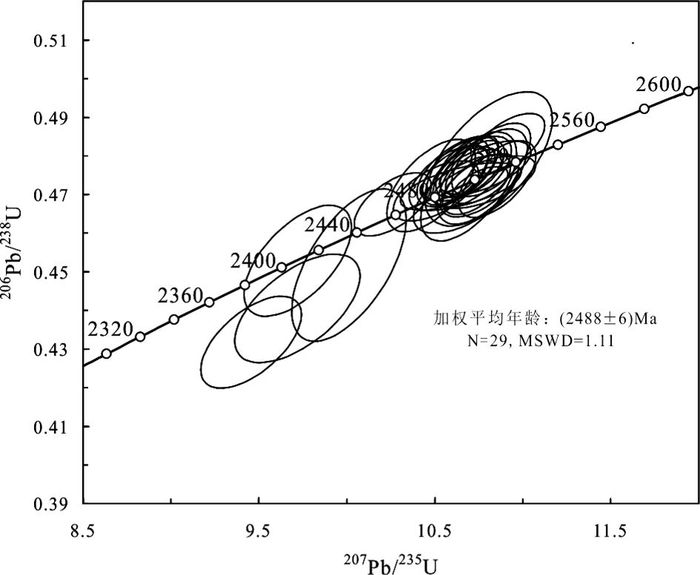
|
图 5 黄岔岩体锆石U-Pb年龄谐和图 Fig. 5 U-Pb concordia of zircon from the Huangcha granite in the Zanhuang Complex |
对黄岔岩体的5个样品进行了主量和微量元素的测试,结果和有关参数见表 2。
|
|
表 2 黄岔岩体主量元素(wt%)、稀土元素和微量元素(×10-6)分析结果 Table 2 Geochemical composition of the Huangcha granite in the Zanhuang Complex (major elements: wt%; rare earth elements and trace elements: ×10-6) |
黄岔岩体富硅(SiO2=72.64%~74.16%)、高钾(K2O=3.53%~6.15%)、富碱(ALK=7.59%~9.07%)及铁(Fe2O3T=1.84%~3.03%),贫钙(CaO=0.67%~1.67%)、低钛(TiO2=0.18%~0.28%)、低镁(MgO=0.31%~0.46%),FeOT/MgO值(4.87~7.87) 较高。岩石的Mg#值(19~27) 较低,相对于高硅含量的岩石来说,该岩体铝含量较高(Al2O3=12.74%~14.11%),铝饱和指数A/CNK=1.01~1.09,平均1.05,A/NK值在1.18~1.34,均表现为(弱)过铝质特征(图 6a)。岩石中K2O含量较高,且与SiO2无相关性,在SiO2-K2O中只有1个样品落入高钾钙碱性系列,其余样品投点于钾玄岩系列(图 6b)。
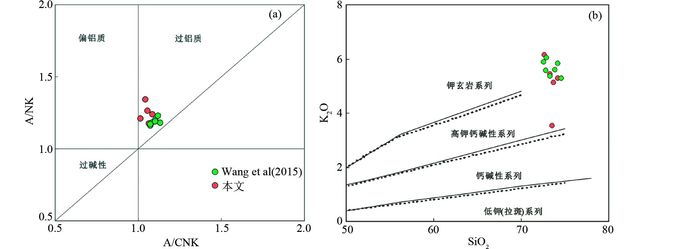
|
图 6 黄岔岩体A/NK-A/CNK (a)和SiO2-K2O (b)关系图解 图b中实线据Peccerillo and Taylor (1976),虚线据Middlemost (1985) Fig. 6 Geochemical diagrams of the Huangcha granite in the Zanhuang Complex Solid line after Peccerillo and Taylor (1976), dashed line after Middlemost (1985) in Fig. 6b |
黄岔岩体的稀土元素总量高(表 2)且变化较大(ΣREE=364.2×10-6~661.1×10-6)。轻稀土总量较高,为342.4×10-6~620.9×10-6;重稀土总量低,为21.7×10-6~40.2×10-6。在球粒陨石标准化稀土元素配分图中表现为右倾的曲线(图 7a),轻重稀土具有较强烈分异特征((La/Yb)N=17.6~28.1),并具有明显的负Eu异常(Eu/Eu*=0.23~0.33,Eu/Eu*=2EuN/(SmN+GdN))。

|
图 7 黄岔岩体球粒陨石标准化稀土元素配分曲线(a)和原始地幔标准化微量元素蜘蛛图(b)(标准化值据Sun and McDonough, 1989) Fig. 7 Chondrite-normalized REE distribution patterns (a) and primitive mantle-normalized spidergrams (b) of the Huangcha granite in the Zanhuang Complex (normalization values after Sun and McDonough, 1989) |
在微量元素中,黄岔岩体高Zr (244×10-6~404×10-6)、Zn (39.4×10-6~66.1×10-6)、Nb (14.4×10-6~26.3×10-6)、Ga (20.5×10-6~21.6×10-6)、Y (30.7×10-6~51.4×10-6),而贫Sr、V、Cr、Co、Ni。岩石具有较低的Sr含量(100×10-6~214×10-6,平均130.8×10-6)和较高的Yb含量(2.62×10-6~4.02×10-6,平均3.53×10-6),类似于张旗等(2006)划分的低Sr高Yb型花岗岩(Sr < 400×10-6,Yb>2×10-6)。在原始地幔标准化微量元素配分图解中,所有样品具有非常明显的Ba、Sr、P、Ti、Nb和Ta负异常(图 7b)。
6 同位素地球化学特征本次测试对样品Z119-1的31粒锆石进行了Hf同位素分析,锆石的Hf同位素分析结果如表 3所示。所有锆石分析点的176Lu/177Hf值均小于0.002,显示锆石在形成以后具有较低放射性成因Hf的积累。分析点的176Hf/177Hf值分布于0.281266~0.281412之间。以锆石单点207Pb/206Pb年龄计算的εHf(t)值在0.96~6.2之间,大部分测点的εHf(t)值均大于0(除Z119-1-1.1外)。单阶段Hf模式年龄(tDM1)为2552~2746Ma,两阶段Hf模式年龄(tDM2)为2576~2826Ma (表 3)。
|
|
表 3 黄岔岩体锆石Lu-Hf同位素组成 Table 3 Zircon Lu-Hf isotopic composition of the Huangcha granite in the Zanhuang Complex |
此外,Wang et al.(2015)曾对黄岔岩体进行过Sm-Nd同位素分析,将其中的143Nd/144Ndi用本次研究所得年龄2488Ma进行重新计算,结果见表 4,其εNd(t)值为-0.06~0.88之间,单阶段亏损地幔模式年龄tDM1为2746~2851Ma,两阶段亏损地幔模式年龄tDM2为2790~2867Ma。样品的fSm/Nd值均为变化范围不大的负值(-0.41~-0.47),说明源区Sm、Nd元素分馏不明显,计算的Nd模式年龄具有明确的地质意义。
|
|
表 4 黄岔岩体的Sm-Nd同位素组成(据Wang et al., 2015数据重新计算) Table 4 Sm-Nd isotopic composition of the Huangcha granite in the Zanhuang Complex (recalculating according to the data from Wang et al., 2015) |
1:5万将军墓幅区域地质调查报告(河北省地质矿产局第十一地质大队,1996)从黄岔岩体中获得单颗粒锆石蒸发法Pb-Pb年龄为2210Ma,初步限定该花岗岩的时代为古元古代。而Wang et al. (2015)从王家庄岩体(即黄岔岩体)中获得3个样品的锆石年龄结果分别为2517±20Ma、2513±13Ma和2506±10Ma,从而限定黄岔花岗岩的时代为新太古代。本文利用LA-ICP-MS获得黄岔岩体的时代为2488±6Ma,与SHRIMP锆石U-Pb年龄结果2487±11Ma (李伦等,未发表数据)在误差范围内完全一致。因而较准确的限定黄岔岩体的时代为新太古代末期。
前已述及,官都群作为赞皇杂岩重要的地质单元之一,由于其主要由变质基性火山岩和沉积岩组成,地层时代难以准确限定。因此,自官都群从原赞皇群中解体建群之后,其时代存在新太古代和古元古代早期两种不同的认识(王启超等,2008;杨崇辉等,2015)。本文通过黄岔岩体局部包裹和侵入官都群石英岩的野外地质证据,进一步推断认为黄岔岩体侵入于官都群中,官都群应早于该岩体。因此根据黄岔岩体2.49Ga年龄结果,限定官都群时代应为太古宙,而非古元古代。但官都群与赞皇群的具体关系还有待进一步研究。
7.2 岩浆源区及成因黄岔岩体高SiO2、Na2O+K2O、FeOT/MgO值,低CaO,富REEs (Eu除外)、Zn、Zr、Nb、Ga和Y等元素,而Sr含量低,具有典型A型花岗岩特征(Collins et al., 1982;Whalen et al., 1987;Eby, 1990;Patiño Douce, 1997)。同时,所有的黄岔花岗岩样品都具有高的Ga/Al值(2.75×10-4~3.11×10-4),属于A型花岗岩的Ga/Al值范围(Whalen et al., 1987)。在10000Ga/Al-(Na2O+K2O)和10000Ga/Al-FeOT/MgO判别图解中,均落入A型花岗岩区域(图 8)。相对其他的花岗岩类型,A型花岗岩具有较高的形成温度(King et al., 1997),一般认为,锆石饱和温度可以近似代表花岗质岩石近液相线的温度(Watson and Harrison, 1983),黄岔岩体样品中未发现残留锆石,因此可以使用Watson and Harrision (1983)锆石饱和温度计。计算得出黄岔岩体锆石饱和温度在826~877℃之间(表 2),平均温度853℃。该温度明显高于S型花岗岩平均温度764℃和I型花岗岩平均温度781℃(King et al., 1997)而与世界范围内典型的A型花岗岩温度相近(Clemens et al., 1986;King et al., 2001;Miller et al., 2003;Bonin, 2007;Zhao et al., 2008b)。因此,黄岔岩体应属于A型花岗岩。
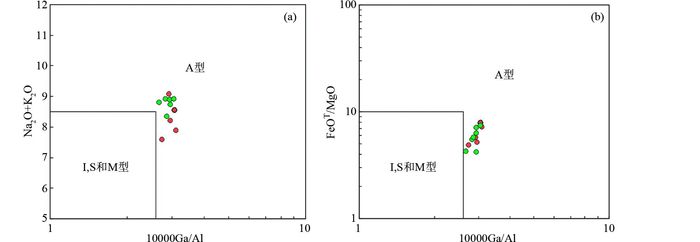
|
图 8 黄岔岩体10000Ga/Al-(Na2O+K2O) (a)和10000Ga/Al-FeOT/MgO (b)关系图(据Whalen et al., 1987) Fig. 8 10000Ga/Al vs. (Na2O+K2O) (a) and 10000Ga/Al vs. FeOT/MgO (b) diagrams of the Huangcha granite in the Zanhuang Complex (after Whalen et al., 1987) |
关于A型花岗岩的成因模式主要有以下几种观点:(1) 幔源碱性玄武质岩浆的直接分异产物(Loiselle and Wones, 1979;Turner et al., 1992;Frost and Frost, 1997;Litvinovsky et al., 2002;Auwera et al., 2003;Mushkin et al., 2003;Namur et al., 2011);(2) 富F或Cl的干的长英质麻粒岩残余物在下地壳的部分熔融(Collins et al., 1982;Clemens et al., 1986;Whalen et al., 1987);(3) 花岗质岩浆与幔源基性岩浆的混合作用(Bédard, 1990;Kerr and Fryer, 1993;Mingram et al., 2000);(4) 地壳浅部钙碱性花岗岩的部分脱水熔融(Anderson, 1983;King et al., 1997, 2001;Patiño Dounce, 1997;Skjerlie and Johnston, 1993)。黄岔岩体明显高硅、富钾、贫镁、低铬,因此其不可能由地幔直接分异而来。Creaser et al.(1991)通过实验证明由富F或Cl的干的长英质麻粒岩残余物在下地壳部分熔融产生的花岗岩相对富Ca、Al、Mg、Fe而亏损K、Si,黄岔岩体的主量元素特征显然与其不相符。本次选择的花岗岩样品中锆石εHf(t)变化范围较大(0.96~6.2),单阶段和二阶段模式年龄分别为2552~2746Ma和2576~2826Ma (表 3)。在εHf(t)-年龄图解中,31个分析点基本落在亏损地幔和球粒陨石演化线之间(图 9)。一种可能是亏损地幔和古老地壳物质的混合,另一种可能是新老不同时代地壳的部分熔融形成的。对于壳幔混合成因的A型花岗岩,除同位素表现为明显的混合特征外,花岗岩中幔源暗色包体较为常见(Yang et al., 2008)。而详细的野外调查发现,黄岔岩体中并未发现幔源的暗色包体,岩体边缘相仅出现细粒的片麻岩(围岩)包体。因而,也可以排除该岩体的壳幔混合成因。已有实验结果证实,A型花岗岩可以由TTG和石英闪长岩在高温低压条件下部分熔融形成(Anderson, 1983;Creaser et al., 1991;Skjerlie and Johnston, 1992;King et al., 1997, 2001;Dall’Agnol et al., 1999)。在赞皇地区,2.7Ga和2.55~2.50Ga的新太古代TTG片麻岩广泛分布(河北省地质矿产局, 1989;杨崇辉等, 2011b, 2015;Yang et al., 2013) (图 1)。同时,黄岔岩体锆石两阶段Hf模式年龄为2.5~2.8Ga (表 3、图 9),该模式年龄与赞皇地区TTG片麻岩年龄基本一致(杨崇辉等, 2011b, 2015;Yang et al., 2013)。因此,我们推测黄岔岩体是由新太古代TTG片麻岩发生部分熔融形成。
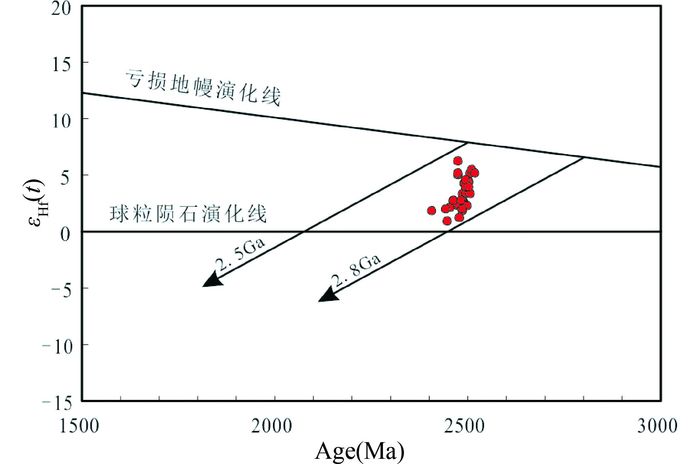
|
图 9 黄岔岩体中锆石εHf(t)-Age图解 Fig. 9 Zircon εHf(t) vs. Age plot for the granites in the Huangcha pluton |
A型花岗岩通常形成于伸展的构造环境中,既可以是造山后的伸展环境,也可以是非造山的裂谷环境,比如陆内裂谷或者弧后盆地(Eby, 1990, 1992;Hong et al., 1996;Zhao et al., 2008b)。在Pearce et al.(1984)的花岗岩构造判别图解中,黄岔岩体皆位于后碰撞构造区域(图 10)。在进一步划分A型花岗岩构造环境相关图解中(Eby, 1992),黄岔岩体皆位于A2型区域(图 11),即造山后伸展环境。此外,在微量元素中,黄岔岩体具有低Sr高Yb的特征(表 2),类似于张旗等(2006)提出的低Sr高Yb型的花岗岩,应形成压力较低( < 0.8或1.0GPa),可能是在正常地壳厚度下(~30km)形成的。在赞皇地区,杨崇辉等(2011b, 2015)通过赞皇杂岩中新太古代末期花岗岩的研究认为,区域内2.55~2.50Ga的TTG片麻岩具有岛弧花岗岩的特征,应代表俯冲板片的部分熔融,而TTG片麻岩之后的二长花岗质片麻岩,如菅等花岗岩(2490±13Ma),形成于由挤压碰撞造山到造山后伸展的过渡环境。本文研究的黄岔岩体比菅等岩体形成时代略晚一些,且形成于伸展环境。此外,Xiao et al.(2014)在赞皇杂岩中获得2507±15Ma的变质锆石年龄结果,并认为其代表了在华北克拉通内部发生区域麻粒岩相变质事件的时代。因此,综合分析认为,黄岔岩体应形成于造山后伸展环境。

|
图 10 黄岔岩体Rb-(Y+Nb)构造环境判别图(据Pearce et al., 1984) Fig. 10 Nb vs. (Y+Nb) tectonic discrimination diagram of the Huangcha granite in the Zanhuang Complex (after Pearce et al., 1984) |
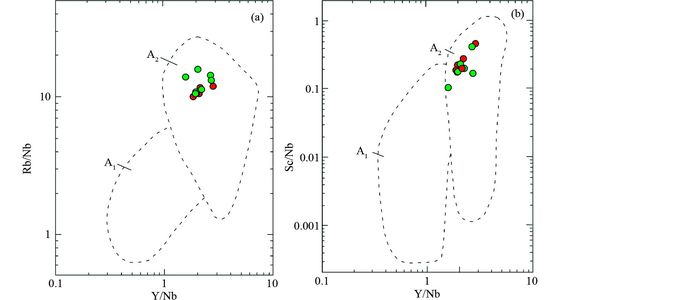
|
图 11 黄岔岩体Rb/Nb-Y/Nb (a)和Sc/Nb-Y/Nb (b)判别图(据Eby, 1992) A1-非造山A型花岗岩,A2-造山后A型花岗岩 Fig. 11 Rb/Nb versus Y/Nb (a) and Sc/Nb versus Y/Nb (b) tectonic discrimination diagrams of Huangcha granite in the Zanhuang Complex (after Eby, 1992) |
华北克拉通约2.55~2.50Ga岩浆热事件非常强烈(沈其韩等,2005;耿元生等,2010),主要表现为分布在东部地块和中部带花岗质岩浆活动,且具有相似的地球化学特征,应该形成于相近的构造环境(Wang et al., 2015)。但对这些花岗质岩石的性质还存在争议,尽管一些学者认为其与地幔柱底侵有关(Geng et al., 2012;Lu et al., 2008;Wu et al., 2012;Zhao et al., 2012;Zhao and Guo, 2012),但大多数学者认为,这些花岗岩是与俯冲有关的岛弧构造背景俯冲板片和/或下地壳部分熔融的产物(Liu et al., 1985, 1990;Wilde et al., 1997, 2005;Kröner et al., 1998;Zhao et al., 2002, 2005, 2008a, 2011;李江海等, 2006;Trap et al., 2009b;万渝生等, 2009;Huang et al., 2010;Nutman et al., 2011;Wan et al., 2010, 2012;Zhang et al., 2011;杨崇辉等, 2011b;Peng et al., 2013;Wang et al., 2013;Deng et al., 2014)。而Wan et al.(2012)通过对华北不同地区2.52~2.50Ga的正长花岗岩总结研究发现,该类花岗岩形成于伸展的构造环境,标志着太古代末期初步完成克拉通化(Zhai and Santosh, 2011)。此外,华北克拉通内较广泛发育的古元古代中期2.2~2.0Ga的岩浆事件表现为双峰式组合,具有陆内裂谷特征(杨崇辉等, 2011a;Du et al., 2013, 2016a及其中文献),也进一步支持华北太古代末期初步克拉通化的认识(Zhai and Santosh, 2011)。
8 结论黄岔岩体为A型花岗岩,其侵位时代为2488±6Ma,为新太古代末期。结合其与官都群的侵入关系,限定官都群的时代为太古代,而非古元古代。黄岔岩体为赞皇地区新太古代TTG在地壳浅部部分熔融形成的,形成于造山后伸展的构造环境。结合华北区域上2.5Ga碱性花岗岩的分布,表明太古代末期华北已初步克拉通化。
| [] | Andersen T. 2002. Correction of common lead in U-Pb analyses that do not report 204Pb. Chemical Geology, 192(1-2): 59–79. DOI:10.1016/S0009-2541(02)00195-X |
| [] | Anderson JL. 1983. Proterozoic anorogenic granite plutonism of North America. In:Medaris Jr LG, Byers CW, Mickelson DM and Shanks WC (eds.). Proterozoic Geology:Selected Papers from an International Proterozoic Symposium. Washington DC:Geological Society of America, 133-154 |
| [] | Auwera JV, Bogaerts M, Liégeois JP, Demaiffe D, Wilmart E, Bolle O, Duchesne JC. 2003. Derivation of the 1.0~0.9Ga ferro-potassic A-type granitoids of southern Norway by extreme differentiation from basic magmas. Precambrian Research, 124(2-4): 107–148. DOI:10.1016/S0301-9268(03)00084-6 |
| [] | Bédard J. 1990. Enclaves from the A-type granite of the Mégantic Complex, White Mountain Magma Series:Clues to granite magmagenesis. Journal of Geophysical Research:Solid Earth, 95(B11): 17797–17819. DOI:10.1029/JB095iB11p17797 |
| [] | Black LP, Kamo SL, Allen CM, Aleinikoff JN, Davis DW, Korsch RJ, Foudoulis C. 2003. TEMORA 1:A new zircon standard for Phanerozoic U-Pb geochronology. Chemical Geology, 200(1-2): 155–170. DOI:10.1016/S0009-2541(03)00165-7 |
| [] | Blichert-Toft J, Albarède F. 1997. The Lu-Hf isotope geochemistry of chondrites and the evolution of the mantle-crust system. Earth and Planetary Science Letters, 148(1-2): 243–258. DOI:10.1016/S0012-821X(97)00040-X |
| [] | Bonin B. 2007. A-type granites and related rocks:Evolution of a concept, problems and prospects. Lithos, 97(1-2): 1–29. DOI:10.1016/j.lithos.2006.12.007 |
| [] | Bureau of Geology and Mineral Resources of Hebei Province. 1989. Regional Geology of Beijing, Tianjin and Hebei Province. Beijing:Geological Publishing House, 16-30, 347-351, 353-354 (in Chinese) |
| [] | Chu NC, Taylor RN, Chavagnac V, Nesbitt RW, Boella RM, Milton JA, German CR, Bayon G, Burton K. 2002. Hf isotope ratio analysis using multi-collector inductively coupled plasma mass spectrometry:An evaluation of isobaric interference corrections. Journal of Analytical Atomic Spectrometry, 17(12): 1567–1574. DOI:10.1039/b206707b |
| [] | Clemens JD, Holloway JR, White AJR. 1986. Origin of an A-type granite:Experimental constraints. American Mineralogist, 71(3-4): 317–324. |
| [] | Collins WJ, Beams SD, White AJR, Chappell BW. 1982. Nature and origin of A-type granites with particular reference to southeastern Australia. Contributions to Mineralogy and Petrology, 80(2): 189–200. DOI:10.1007/BF00374895 |
| [] | Creaser RA, Price RC, Wormald RJ. 1991. A-type granites revisited:Assessment of a residual-source model. Geology, 19(2): 163–166. DOI:10.1130/0091-7613(1991)019<0163:ATGRAO>2.3.CO;2 |
| [] | Dall'Agnol R, Scaillet B, Pichavant M. 1999. An experimental study of a lower Proterozoic A-type granite from the eastern Amazonian Craton, Brazil. Journal of Petrology, 40(11): 1673–1698. DOI:10.1093/petroj/40.11.1673 |
| [] | Deng H, Kusky TM, Polat A, Wang L, Wang JP, Wang SJ. 2013. Geochemistry of Neoarchean mafic volcanic rocks and late mafic dikes in the Zanhuang Complex, Central Orogenic Belt, North China Craton:Implications for geodynamic setting. Lithos, 175-176: 193–212. DOI:10.1016/j.lithos.2013.05.007 |
| [] | Deng H, Kusky T, Polat A, Wang JP, Wang L, Fu JM, Wang ZS, Yuan Y. 2014. Geochronology, mantle source composition and geodynamic constraints on the origin of Neoarchean mafic dikes in the Zanhuang Complex, Central Orogenic Belt, North China Craton. Lithos, 205: 359–378. DOI:10.1016/j.lithos.2014.07.011 |
| [] | Du LL, Yang CH, Wang W, Ren LD, Wan YS, Wu JS, Zhao L, Song HX, Geng YS, Hou KJ. 2013. Paleoproterozoic rifting of the North China Craton:Geochemical and zircon Hf isotopic evidence from the 2137Ma Huangjinshan A-type granite porphyry in the Wutai area. Journal of Asian Earth Sciences, 72: 190–202. DOI:10.1016/j.jseaes.2012.11.040 |
| [] | Du LL, Yang CH, Wyman DA, Nutman AP, Lu ZL, Song HX, Xie HQ, Wan YS, Zhao L, Geng YS, Ren LD. 2016a. 2090~2070Ma A-type granitoids in Zanhuang Complex:Further evidence on a Paleoproterozoic rift-related tectonic regime in the Trans-North China Orogen. Lithos, 254-255: 18–35. DOI:10.1016/j.lithos.2016.03.007 |
| [] | Du LL, Yang CH, Wyman DA, Nutman AP, Lu ZL, Song HX, Zhao L, Geng YS, Ren LD. 2016b. Age and depositional setting of the Paleoproterozoic Gantaohe Group in Zanhuang Complex:Constraints from zircon U-Pb ages and Hf isotopes of sandstones and dacite. Precambrian Research, 286: 59–100. DOI:10.1016/j.precamres.2016.09.027 |
| [] | Eby GN. 1990. The A-type granitoids:A review of their occurrence and chemical characteristics and speculations on their petrogenesis. Lithos, 26(1-2): 115–134. DOI:10.1016/0024-4937(90)90043-Z |
| [] | Eby GN. 1992. Chemical subdivision of the A-type granitoids:Petrogenetic and tectonic implications. Geology, 20(7): 641–644. DOI:10.1130/0091-7613(1992)020<0641:CSOTAT>2.3.CO;2 |
| [] | Feio GRL, Dall'Agnol R, Dantas EL, Macambira MJB, Gomes ACB, Sardinha AS, Oliveira DC, Santos RD, Santos PA. 2012. Geochemistry, geochronology, and origin of the Neoarchean Planalto Granite suite, Carajás, Amazonian craton:A-type or hydrated charnockitic granites?. Lithos, 151: 57–73. DOI:10.1016/j.lithos.2012.02.020 |
| [] | Frost CD, Frost BR. 1997. Reduced rapakivi-type granites:The tholeiite connection. Geology, 25(7): 647–650. DOI:10.1130/0091-7613(1997)025<0647:RRTGTT>2.3.CO;2 |
| [] | Geng JZ, Li HK, Zhang J, Zhou HY, Li HM. 2011. Zircon Hf isotope analysis by means of LA-MC-ICP-MS. Geological Bulletin of China, 30(10): 1508–1513. |
| [] | Geng YS, Shen QH, Ren LD. 2010. Late Neoarchean to Early Paleoproterozoic magmatic events and tectonothermal systems in the North China Craton. Acta Petrologica Sinica, 26(7): 1945–1966. |
| [] | Geng YS, Du LL, Ren LD. 2012. Growth and reworking of the Early Precambrian continental crust in the North China Craton:Constraints from zircon Hf isotopes. Gondwana Research, 21(2-3): 517–529. DOI:10.1016/j.gr.2011.07.006 |
| [] | Griffin WL, Pearson NJ, Belousova E, Jackson SE, van Achterbergh E, O'Reilly SY, Shee SR. 2000. The Hf isotope composition of cratonic mantle:LAM-MC-ICPMS analysis of zircon megacrysts in kimberlites. Geochimica et Cosmochimica Acta, 64(1): 133–147. DOI:10.1016/S0016-7037(99)00343-9 |
| [] | Griffin WL, Wang X, Jackson SE, Pearson NJ, O'Reilly SY, Xu XS, Zhou XM. 2002. Zircon chemistry and magma mixing, SE China:In-situ analysis of Hf isotopes, Tonglu and Pingtan igneous complexes. Lithos, 61(3-4): 237–269. DOI:10.1016/S0024-4937(02)00082-8 |
| [] | Hong DW, Wang SG, Han BF, Jin MY. 1996. Post-orogenic alkaline granites from China and comparisons with anorogenic alkaline granites elsewhere. Journal of Southeast Asian Earth Sciences, 13(1): 13–27. DOI:10.1016/0743-9547(96)00002-5 |
| [] | Huang XL, Niu YL, Xu YG, Yang QJ, Zhong JW. 2010. Geochemistry of TTG and TTG-like gneisses from Lushan-Taihua complex in the southern North China Craton:Implications for Late Archean crustal accretion. Precambrian Research, 182(1-2): 43–56. DOI:10.1016/j.precamres.2010.06.020 |
| [] | Jackson SE, Pearson NJ, Griffin WL, Belousova EA. 2004. The application of laser ablation-inductively coupled plasma-mass spectrometry to in situ U-Pb zircon geochronology. Chemical Geology, 211(1-2): 47–69. DOI:10.1016/j.chemgeo.2004.06.017 |
| [] | Kerr A, Fryer BJ. 1993. Nd isotope evidence for crust-mantle interaction in the generation of A-type granitoid suites in Labrador, Canada. Chemical Geology, 104(1-4): 39–60. DOI:10.1016/0009-2541(93)90141-5 |
| [] | King PL, White AJR, Chappell BW, Allen CM. 1997. Characterization and origin of aluminous A-type granites from the Lachlan Fold Belt, southeastern Australia. Journal of Petrology, 38(3): 371–391. DOI:10.1093/petroj/38.3.371 |
| [] | King PL, Chappell BW, Allen CM, White AJR. 2001. Are A-type granites the high-temperature felsic granites? Evidence from fractionated granites of the Wangrah Suite. Australian Journal of Earth Sciences, 48(4): 501–514. DOI:10.1046/j.1440-0952.2001.00881.x |
| [] | Krröner A, Cui WY, Wang SQ, Wang CQ, Nemchin AA. 1998. Single zircon ages from high-grade rocks of the Jianping Complex, Liaoning Province, NE China. Journal of Asian Earth Sciences, 16(5-6): 519–532. DOI:10.1016/S0743-9547(98)00033-6 |
| [] | Kusky TM, Li JH. 2003. Paleoproterozoic tectonic evolution of the North China Craton. Journal of Asian Earth Sciences, 22(4): 383–397. DOI:10.1016/S1367-9120(03)00071-3 |
| [] | Kusky TM, Li JH, Santosh M. 2007. The Paleoproterozoic North Hebei Orogen:North China craton's collisional suture with the Columbia supercontinent. Gondwana Research, 12(1-2): 4–28. DOI:10.1016/j.gr.2006.11.012 |
| [] | Kusky TM, Li JH, Ploat A, Wang JP, Deng H, Wang L. 2015. The Zunhua-Zanhuang ophiolitic mélange:Traces of an Archean suture in the North China Craton. Acta Geologica Sinica, 89(Suppl.2): 37–38. |
| [] | Lei SH, Hu SJ, Zhao ZY, Jiang XW, Wang SD. 1994. Models for Fuping-Zanhuang metamorphic bicore complexes structure, Hebei, China. Journal of Hebei College of Geology, 17(1): 54–64. |
| [] | Li HK, Geng JZ, Hao S, Zhang YQ, Li HM. 2009. Research of determination of U-Pb isotopic age of zircon by laser ablation multi collector plasma mass spectrometer (LA-MC-ICPMS). Acta Mineralogica Sinica, 29(Suppl.1): 600–601. |
| [] | Li JH, Qian XL, Huang XN, Liu SW. 2000. Tectonic framework of North China Block and its cratonization in the Early Precambrian. Acta Petrologica Sinica, 16(1): 1–10. |
| [] | Li JH, Niu XL, Kusky T, Polat A. 2004. Neoarchean plate tectonic evolution of North China and its correlation with global cratonic blocks. Earth Science Frontiers, 11(3): 273–283. |
| [] | Li JH, Hou GT, Liu SJ. 2006. The Early Precambrian collisional orogenic process and plate tectonics:Chance and challenge of Precambrian geology. Advances in Earth Science, 21(8): 843–848. |
| [] | Li SS, Santosh M, Teng XM, He XF. 2016. Paleoproterozoic arc-continent collision in the North China Craton:Evidence from the Zanhuang Complex. Precambrian Research, 286: 281–305. DOI:10.1016/j.precamres.2016.10.008 |
| [] | Lin W, Faure M, Monié P and Wang QC. 2007. Polyphase Mesozoic tectonics in the eastern part of the North China Block:Insights from the eastern Liaoning Peninsula massif (NE China). In:Zhai MG, Windley BF, Kusky TM and Meng QR (eds.). Mesozoic Sub-Continental Lithospheric Thinning Under Eastern Asia. Geological Society, London, Special Publications, 280(1):153-169 |
| [] | Litvinovsky BA, Jahn BM, Zanvilevich AN, Saunders A, Poulain S, Kuzmin DV, Reichow MK, Titov AV. 2002. Petrogenesis of syenite-granite suites from the Bryansky Complex (Transbaikalia, Russia):Implications for the origin of A-type granitoid magmas. Chemical Geology, 189(1-2): 105–133. DOI:10.1016/S0009-2541(02)00142-0 |
| [] | Liu CH, Zhao GC, Liu FL, Sun M, Zhang J, Yin CQ. 2012. Zircons U-Pb and Lu-Hf isotopic and whole-rock geochemical constraints on the Gantaohe Group in the Zanhuang Complex:Implications for the tectonic evolution of the Trans-North China Orogen. Lithos, 146-147: 80–92. DOI:10.1016/j.lithos.2012.04.033 |
| [] | Liu DY, Page RW, Compston W, Wu JS. 1985. U-Pb zircon geochronology of late Archaean metamorphic rocks in the Taihangshan-Wutaishan area, North China. Precambrian Research, 27(1-3): 85–109. DOI:10.1016/0301-9268(85)90007-5 |
| [] | Liu DY, Shen QH, Zhang ZQ, Jahn BM, Auvray B. 1990. Archean crustal evolution in China:U-Pb geochronology of the Qianxi Complex. Precambrian Research, 48(3): 223–244. DOI:10.1016/0301-9268(90)90010-N |
| [] | Loiselle MC, Wones DR. 1979. Characteristics and origin of anorogenic granites. Geological Society of America Abstracts with Program, 11(7): 468. |
| [] | Lu SN, Zhao GC, Wang HC, Hao GJ. 2008. Precambrian metamorphic basement and sedimentary cover of the North China Craton:A review. Precambrian Research, 160(1-2): 77–93. DOI:10.1016/j.precamres.2007.04.017 |
| [] | Lu XP, Wu FY, Zhang YB, Zhao CB, Guo CL. 2004a. Emplacement age and tectonic setting of the Paleoproterozoic Liaoji granites in Tonghua area, southern Jilin Province. Acta Petrologica Sinica, 20(3): 381–392. |
| [] | Lu XP, Wu FY, Lin JQ, Sun DY, Zhang YB, Guo CL. 2004b. Geochronological successions of the Early Precambrian granitic magmatism in southern Liaodong Peninsula and its constraints on tectonic evolution of the North China Craton. Chinese Journal of Geology, 39(1): 123–138. |
| [] | Ludwig KR. 2001. User's Manual for Isoplot/Ex Rev. 2.49:A Geochronological Toolkit for Microsoft Excel. Berkeley:Berkeley Geochronology Centre. Special Publication, 1: 55. |
| [] | Middlemost EAK. 1985. Magmas and Magmatic Rocks:An Introduction to Igneous Petrology. London:Longman Higher Education |
| [] | Miller CF, McDowell SM, Mapes RW. 2003. Hot and cold granites? Implications of zircon saturation temperatures and preservation of inheritance. Geology, 31(6): 529–532. DOI:10.1130/0091-7613(2003)031<0529:HACGIO>2.0.CO;2 |
| [] | Mingram B, Trumbull RB, Littman S, Gerstenberger H. 2000. A petrogenetic study of anorogenic felsic magmatism in the Cretaceous Paresis ring complex, Namibia:Evidence for mixing of crust and mantle-derived components. Lithos, 54(1-2): 1–22. DOI:10.1016/S0024-4937(00)00033-5 |
| [] | Mushkin A, Navon O, Halicz L, Hartmann G, Stein M. 2003. The petrogenesis of A-type magmas from the Amram Massif, Southern Israel. Journal of Petrology, 44(5): 815–832. DOI:10.1093/petrology/44.5.815 |
| [] | Namur O, Charlier B, Toplis MJ, Higgins MD, Hounsell V, Liégeois JP, Vander Auwera J. 2011. Differentiation of Tholeiitic basalt to A-type granite in the sept iles layered intrusion, Canada. Journal of Petrology, 52(3): 487–539. DOI:10.1093/petrology/egq088 |
| [] | Niu SY, Chen L, Xu CS, Dong GR, Guo LJ, Wang LS, Qin MT, Ma JL, Zhou DX, Lv BL, Shi JZ, Li HY, Guo ZF, Hao JM. 1994a. The Crustal Evolution and Metallogenic Regularity of the Taihangshan Area. Beijing: Seismological Press: 1-90. |
| [] | Niu SY, Xu CS, Guo LJ, Chen L. 1994b. The study of origin and characteristics of the Taihangshan metamorphic core complexes. Journal of Hebei College of Geology, 17(1): 43–53. |
| [] | Nutman AP, Wan YS, Du LL, Friend CRL, Dong CY, Xie HQ, Wang W, Sun HY, Liu DY. 2011. Multistage Late Neoarchaean crustal evolution of the North China Craton, eastern Hebei. Precambrian Research, 189(1-2): 43–65. DOI:10.1016/j.precamres.2011.04.005 |
| [] | Patchett PJ, Tatsumoto M. 1981. A routine high-precision method for Lu-Hf isotope geochemistry and chronology. Contributions to Mineralogy and Petrology, 75(3): 263–267. DOI:10.1007/BF01166766 |
| [] | Patiño Douce AE. 1997. Generation of metaluminous A-type granites by low-pressure melting of calc-alkaline granitoids. Geology, 25(8): 743–746. DOI:10.1130/0091-7613(1997)025<0743:GOMATG>2.3.CO;2 |
| [] | Pearce JA, Harris NBW, Tindle AG. 1984. Trace element discrimination diagrams for the tectonic interpretation of granitic rocks. Journal of Petrology, 25(4): 956–983. DOI:10.1093/petrology/25.4.956 |
| [] | Peccerillo A, Taylor SR. 1976. Geochemistry of eocene calc-alkaline volcanic rocks from the Kastamonu area, Northern Turkey. Contributions to Mineralogy and Petrology, 58(1): 63–81. DOI:10.1007/BF00384745 |
| [] | Peng TP, Wilde SA, Fan WM, Peng BX. 2013. Late Neoarchean potassic high Ba-Sr granites in the Taishan granite-greenstone terrane:Petrogenesis and implications for continental crustal evolution. Chemical Geology, 344: 23–41. DOI:10.1016/j.chemgeo.2013.02.012 |
| [] | Shen QH, Geng YS, Song B, Wan YS. 2005. New information from the surface outcrops and deep crust of Archean rocks of the North China and Yangtze blocks, and Qinling-Dabie Orogenic Belt. Acta Geologica Sinica, 79(5): 616–627. |
| [] | Shen QH. 2009. The recommendation of a systematic list of mineral abbreviations. Acta Petrologica et Mineralogica, 28(5): 495–500. |
| [] | Skjerlie KP, Johnston AD. 1992. Vapor-absent melting at 10kbar of a biotite-and amphibole-bearing tonalitic gneiss:Implications for the generation of A-type granites. Geology, 20(3): 263–266. DOI:10.1130/0091-7613(1992)020<0263:VAMAKO>2.3.CO;2 |
| [] | Sun SS and Mcdonough WF. 1989. Chemical and isotopic systematics of oceanic basalts:Implications for mantle composition and processes. In:Saunders AD and Norry MJ (eds.). Magmatism in the Ocean Basins. Geological Society, London, Special Publications, 42(1):313-345 |
| [] | Tang L, Santosh M, Tsunogae T, Maruoka T. 2016. Paleoproterozoic meta-carbonates from the central segment of the Trans-North China Orogen:Zircon U-Pb geochronology, geochemistry, and carbon and oxygen isotopes. Precambrian Research, 284: 14–29. DOI:10.1016/j.precamres.2016.08.001 |
| [] | Trap P, Faure M, Lin W and Meffre S. 2009a. The luliang massif:A key area for the understanding of the Palaeoproterozoic Trans-North China Belt, North China Craton. In:Reddy SM, Mazumder R, Evans DAD and Collins AS (eds.). Palaeoproterozoic Supercontinents and Global Evolution. Geological Society, London, Special Publications, 323(1):99-125 |
| [] | Trap P, Faure M, Lin W, Monié P, Meffre S, Melleton J. 2009b. The Zanhuang Massif, the second and eastern suture zone of the Paleoproterozoic Trans-North China Orogen. Precambrian Research, 172(1-2): 80–98. DOI:10.1016/j.precamres.2009.03.011 |
| [] | Trap P, Faure M, Lin W, Le Breton N, Monié P. 2012. Paleoproterozoic tectonic evolution of the Trans-North China Orogen:Toward a comprehensive model. Precambrian Research, 222-223: 191–211. DOI:10.1016/j.precamres.2011.09.008 |
| [] | Turner SP, Foden JD, Morrison RS. 1992. Derivation of some A-type magmas by fractionation of basaltic magma:An example from the Padthaway Ridge, South Australia. Lithos, 28(2): 151–179. DOI:10.1016/0024-4937(92)90029-X |
| [] | Wan YS, Liu DY, Wang SY, Zhao X, Dong CY, Zhou HY, Yin XY, Yang CX, Gao LZ. 2009. Early Precambrian crustal evolution in the Dengfeng area, Henan Province (eastern China):Constraints from geochemistry and SHRIMP U-Pb zircon dating. Acta Geologica Sinica, 83(7): 982–999. |
| [] | Wan YS, Liu DY, Wang SJ, Dong CY, Yang EX, Wang W, Zhou HY, Ning ZG, Du LL, Yin XY, Xie HQ, Ma MZ. 2010. Juvenile magmatism and crustal recycling at the end of the Neoarchean in western Shandong Province, North China Craton:Evidence from SHRIMP zircon dating. American Journal of Science, 310(10): 1503–1552. DOI:10.2475/10.2010.11 |
| [] | Wan YS, Dong CY, Liu DY, Kröner A, Yang CH, Wang W, Du LL, Xie HQ, Ma MZ. 2012. Zircon ages and geochemistry of Late Neoarchean syenogranites in the North China Craton:A review. Precambrian Research, 222-223: 265–289. DOI:10.1016/j.precamres.2011.05.001 |
| [] | Wang JP, Kusky T, Polat A, Wang L, Deng H, Wang SJ. 2013. A late Archean tectonic mélange in the Central Orogenic Belt, North China Craton. Tectonophysics, 608: 929–946. DOI:10.1016/j.tecto.2013.07.025 |
| [] | Wang JP, Kusky T, Wang L, Polat A, Deng H. 2015. A Neoarchean subduction polarity reversal event in the North China Craton. Lithos, 220-223: 133–146. DOI:10.1016/j.lithos.2015.01.029 |
| [] | Wang JP, Kusky T, Wang L, Polat A, Wang SJ, Deng H, Fu JM, Fu D. 2017. Petrogenesis and geochemistry of circa 2.5Ga granitoids in the Zanhuang Massif:Implications for magmatic source and Neoarchean metamorphism of the North China Craton. Lithos, 268-271: 149–162. DOI:10.1016/j.lithos.2016.10.028 |
| [] | Wang QC, Wang QT, Xiao WX, Shen XP. 2008. Some problems of Archean strata in the Taihang Mountains. Journal of Stratigraphy, 32(4): 439–446. |
| [] | Wang YJ, Fan WM, Zhang Y, Guo F. 2003. Structural evolution and 40Ar/39Ar dating of the Zanhuang metamorphic domain in the North China Craton:Constraints on Paleoproterozoic tectonothermal overprinting. Precambrian Research, 122(1-4): 159–182. DOI:10.1016/S0301-9268(02)00210-3 |
| [] | Wang YJ, Fan WM, Guo F, Peng TP, Li CW. 2003. Biotite 40Ar/39Ar geochronology of the deformational rocks from Zanhuang metamorphic domain in South Taihang Mountains and their tectonothermal overprinting. Acta Petrologica Sinica, 19(1): 131–140. |
| [] | Wang YJ, Fan WM, Zhang YH, Guo F, Zhang HF, Peng TP. 2004. Geochemical, 40Ar/39Ar geochronological and Sr-Nd isotopic constraints on the origin of Paleoproterozoic mafic dikes from the southern Taihang Mountains and implications for the ca. 1800 Ma event of the North China Craton. Precambrian Research, 135(1-2): 55–77. DOI:10.1016/j.precamres.2004.07.005 |
| [] | Wang ZH, Wilde SA, Wan JL. 2010. Tectonic setting and significance of 2.3~2.1Ga magmatic events in the Trans-North China Orogen:New constraints from the Yanmenguan mafic-ultramafic intrusion in the Hengshan-Wutai-Fuping area. Precambrian Research, 178(1-4): 27–42. DOI:10.1016/j.precamres.2010.01.005 |
| [] | Watson EB, Harrison TM. 1983. Zircon saturation revisited:Temperature and composition effects in a variety of crustal magma types. Earth and Planetary Science Letters, 64(2): 295–304. DOI:10.1016/0012-821X(83)90211-X |
| [] | Whalen JB, Currie KL, Chappell BW. 1987. A-type granites:Geochemical characteristics, discrimination and petrogenesis. Contributions to Mineralogy and Petrology, 95(4): 407–419. DOI:10.1007/BF00402202 |
| [] | White AJR, Chappell BW. 1983. Granitoid types and their distribution in the Lachlan Fold Belt, southeastern Australia. Geological Society of America Memoirs, 159(12): 21–34. |
| [] | Wilde SA, Cawood P and Wang KY. 1997. The relationship and timing of granitoid evolution with respect to felsic volcanism in the Wutai Complex, North China Craton. In:Qian XL, You ZD and Halls (eds.). Precambrian Geology and Metamorphic Petrology Proceedings of the 30th International Geological Congress, Volume 17. London:CRC Press, 75-87 |
| [] | Wilde SA, Cawood PA, Wang KY, Nemchin AA. 2005. Granitoid evolution in the Late Archean Wutai Complex, North China Craton. Journal of Asian Earth Sciences, 24(5): 597–613. DOI:10.1016/j.jseaes.2003.11.006 |
| [] | Wu FY, Sun DY, Li HM, Jahn BM, Wilde S. 2002. A-type granites in northeastern China:Age and geochemical constraints on their petrogenesis. Chemical Geology, 187(1-2): 143–173. DOI:10.1016/S0009-2541(02)00018-9 |
| [] | Wu FY, Li XH, Zheng YF, Gao S. 2007. Lu-Hf isotopic systematics and their applications in petrology. Acta Petrologica Sinica, 23(2): 185–220. |
| [] | Wu JS, Geng YS, Shen QH, Wan YS, Liu DY, Song B. 1998. Archaean Geology Characteristics and Tectonic Evolution of China-Korea Paleo-continent. Beijing: Geological Publishing House: 1-104. |
| [] | Wu ML, Zhao GC, Sun M, Yin CQ, Li SZ, Tam PY. 2012. Petrology and P-T path of the Yishui mafic granulites:Implications for tectonothermal evolution of the western Shandong Complex in the Eastern Block of the North China Craton. Precambrian Research, 222-223: 312–324. DOI:10.1016/j.precamres.2011.08.008 |
| [] | Xiao LL, Wang GD. 2011. Zircon U-Pb dating of metabasic rocks in the Zanhuang metamorphic complex and its geological significance. Acta Petrologica et Mineralogica, 30(5): 781–794. |
| [] | Xiao LL, Wu CM, Zhao GC, Guo JH, Ren LD. 2011. Metamorphic P-T paths of the Zanhuang amphibolites and metapelites:Constraints on the tectonic evolution of the Paleoproterozoic Trans-North China Orogen. International Journal of Earth Sciences, 100(4): 717–739. DOI:10.1007/s00531-010-0522-5 |
| [] | Xiao LL, Lu JS, Wang GD, Cai J, Wu CM. 2012. Geochemistry, metamorphic evolution and its tectonic implications of amphibolites in the southwest area of the Zanhuang complex. Acta Petrologica Sinica, 28(9): 2807–2818. |
| [] | Xiao LL, Liu FL, Liu JH, Liu PH, Shi JR, Cai J. 2013. Geochemistry and its tectonic implications of the Zuoquan-Zanhuang complex. Acta Petrologica Sinica, 29(2): 533–550. |
| [] | Xiao LL, Liu FL, Chen Y. 2014. Metamorphic P-T-t paths of the Zanhuang metamorphic complex:Implications for the Paleoproterozoic evolution of the Trans-North China Orogen. Precambrian Research, 255: 216–235. DOI:10.1016/j.precamres.2014.09.027 |
| [] | Xie HQ, Liu DY, Yin XY, Zhou HY, Yang CH, Du LL, Wan YS. 2012. Formation age and tectonic environment of the Gantaohe Group, North China Craton:Geology, geochemistry, SHRIMP zircon geochronology and Hf-Nd isotopic systematics. Chinese Science Bulletin, 57(36): 4735–4745. DOI:10.1007/s11434-012-5482-7 |
| [] | Xu BL, Yan GH, Zhang C, Li ZT, He ZF. 1998. Petrological subdivision and source material of A-type granites. Earth Science Frontiers, 5(3): 113–124. |
| [] | Yang CH, Du LL, Ren LD, Song HX, Wan YS, Xie HQ, Liu ZX. 2011a. The age and petrogenesis of the Xuting granite in the Zanhuang Complex, Hebei Province:Constraints on the structural evolution of the Trans-North China Orogen, North China Craton. Acta Petrologica Sinica, 27(4): 1003–1016. |
| [] | Yang CH, Du LL, Ren LD, Song HX, Wan YS, Xie HQ, Liu ZX. 2011b. Petrogenesis and geodynamic setting of Jiandeng potassic granite at the end of the Neoarchean in Zanhuang Complex, North China Craton. Earth Science Frontiers, 18(2): 62–78. |
| [] | Yang CH, Du LL, Ren LD, Song HX, Wan YS, Xie HQ, Geng YS. 2013. Delineation of the ca. 2.7Ga TTG gneisses in the Zanhuang Complex, North China Craton and its geological implications. Journal of Asian Earth Sciences, 72: 178–189. DOI:10.1016/j.jseaes.2012.09.031 |
| [] | Yang CH, Du LL, Ren LD, Song HX, Wan YS. 2015. Early Precambrian Stratigraphic Division and Magamtic Evolution in the North Chian Craton. Beijing: Science Press: 1-277. |
| [] | Yang JH, Wu FY, Liu XM, Xie LW. 2005. Zircon U-Pb ages and Hf isotopes and their geological significance of the Miyun rapakivi granites from Beijing, China. Acta Petrologica Sinica, 21(6): 1633–1644. |
| [] | Yang JH, Wu FY, Chung SL, Wilde SA, Chu MF. 2006. A hybrid origin for the Qianshan A-type granite, Northeast China:Geochemical and Sr-Nd-Hf isotopic evidence. Lithos, 89(1-2): 89–106. DOI:10.1016/j.lithos.2005.10.002 |
| [] | Yang JH, Wu FY, Wilde SA, Zhao GC. 2008. Petrogenesis and geodynamics of Late Archean magmatism in eastern Hebei, eastern North China Craton:Geochronological, geochemical and Nd-Hf isotopic evidence. Precambrian Research, 167(1-2): 125–149. DOI:10.1016/j.precamres.2008.07.004 |
| [] | Zhai MG, Santosh M. 2011. The Early Precambrian odyssey of the North China Craton:A synoptic overview. Gondwana Research, 20(1): 6–25. DOI:10.1016/j.gr.2011.02.005 |
| [] | Zhang HF, Zhai MG, Santosh M, Diwu CR, Li SR. 2011. Geochronology and petrogenesis of Neoarchean potassic meta-granites from Huai'an Complex:Implications for the evolution of the North China Craton. Gondwana Research, 20(1): 82–105. DOI:10.1016/j.gr.2011.01.009 |
| [] | Zhang Q, Wang Y, Li CD, Wang YL, Jin WJ, Jia XQ. 2006. Granite classification on the basis of Sr and Yb contents and its implications. Acta Petrologica Sinica, 22(9): 2249–2269. |
| [] | Zhao GC, Wilde SA, Cawood PA, Lu LZ. 1998. Thermal evolution of archean basement rocks from the eastern part of the North China Craton and its bearing on tectonic setting. International Geology Review, 40(8): 706–721. DOI:10.1080/00206819809465233 |
| [] | Zhao GC, Cawood P, Lu LZ. 1999. Petrology and P-T history of the Wutai amphibolites:Implications for tectonic evolution of the Wutai Complex, China. Precambrian Research, 93(2-3): 181–199. DOI:10.1016/S0301-9268(98)00090-4 |
| [] | Zhao GC, Wilde SA, Cawood PA, Lu LZ. 2000a. Petrology and P-T path of the Fuping mafic granulites:Implications for tectonic evolution of the central zone of the North China craton. Journal of Metamorphic Geology, 18(4): 375–391. |
| [] | Zhao GC, Cawood PA, Wilde SA, Sun M, Lu LZ. 2000b. Metamorphism of basement rocks in the Central Zone of the North China Craton:Implications for Paleoproterozoic tectonic evolution. Precambrian Research, 103(1-2): 55–88. DOI:10.1016/S0301-9268(00)00076-0 |
| [] | Zhao GC, Cawood PA, Wilde SA, Lu LZ. 2001a. High-pressure granulites (retrograded eclogites) from the Hengshan Complex, North China Craton:Petrology and tectonic implications. Journal of Petrology, 42(6): 1141–1170. DOI:10.1093/petrology/42.6.1141 |
| [] | Zhao GC, Wilde SA, Cawood PA, Sun M. 2001b. Archean blocks and their boundaries in the North China Craton:Lithological, geochemical, structural and P-T path constraints and tectonic evolution. Precambrian Research, 107(1-2): 45–73. DOI:10.1016/S0301-9268(00)00154-6 |
| [] | Zhao GC, Wilde SA, Cawood PA, Sun M. 2002. SHRIMP U-Pb zircon ages of the Fuping Complex:Implications for Late Archean to Paleoproterozoic accretion and assembly of the North China Craton. American Journal of Science, 302(3): 191–226. DOI:10.2475/ajs.302.3.191 |
| [] | Zhao GC, Sun M, Wilde SA, Li SZ. 2005. Late Archean to Paleoproterozoic evolution of the North China Craton:Key issues revisited. Precambrian Research, 136(2): 177–202. DOI:10.1016/j.precamres.2004.10.002 |
| [] | Zhao GC, Wilde SA, Sun M, Guo JH, Kröner A, Li SZ, Li XP, Zhang J. 2008a. SHRIMP U-Pb zircon geochronology of the Huai'an Complex:Constraints on Late Archean to paleoproterozoic magmatic and metamorphic events in the Trans-North China Orogen. American Journal of Science, 308(3): 270–303. DOI:10.2475/03.2008.04 |
| [] | Zhao GC, Yin CQ, Guo JH, Sun M, Li SZ, Li XP, Wu CM, Liu CH. 2010. Metamorphism of the Luliang amphibolite:Implications for the tectonic evolution of the North China Craton. American Journal of Science, 310(10): 1480–1502. DOI:10.2475/10.2010.10 |
| [] | Zhao GC, Cawood PA, Li SZ, Wilde SA, Sun M, Zhang J, He YH, Yin CQ. 2012. Amalgamation of the North China Craton:Key issues and discussion. Precambrian Research, 222-223: 55–76. DOI:10.1016/j.precamres.2012.09.016 |
| [] | Zhao GC, Guo JH. 2012. Precambrian geology of China:Preface. Precambrian Research, 222-223: 1–12. DOI:10.1016/j.precamres.2012.09.018 |
| [] | Zhao GC, Zhai MG. 2012. Lithotectonic elements of Precambrian basement in the North China Craton:Review and tectonic implications. Gondwana Research, 23(4): 1207–1240. |
| [] | Zhao XF, Zhou MF, Li JW, Wu FY. 2008b. Association of Neoproterozoic A-and I-type granites in South China:Implications for generation of A-type granites in a subduction-related environment. Bulletin of Mineralogy, Petrology and Geochemistry, 27(S1): 158. |
| [] | Zhou YY, Zhao TP, Wang CY, Hu GH. 2011. Geochronology and geochemistry of 2.5 to 2.4 Ga granitic plutons from the southern margin of the North China Craton:Implications for a tectonic transition from arc to post-collisional setting. Gondwana Research, 20(1): 171–183. DOI:10.1016/j.gr.2011.03.004 |
| [] | 耿建珍, 李怀坤, 张健, 周红英, 李惠民. 2011. 锆石Hf同位素组成的LA-MC-ICP-MS测定. 地质通报, 30(10): 1508–1513. DOI:10.3969/j.issn.1671-2552.2011.10.004 |
| [] | 耿元生, 沈其韩, 任留东. 2010. 华北克拉通晚太古代末-古元古代初的岩浆事件及构造热体制. 岩石学报, 26(7): 1945–1966. |
| [] | 河北省地质矿产局. 1989. 河北省北京市天津市区域地质志. 北京: 地质出版社, 16-30, 347-351, 353-354 |
| [] | 雷世和, 胡胜军, 赵占元, 姜晓玮, 王士德. 1994. 河北阜平、赞皇变质核杂岩构造及成因模式. 河北地质学院学报, 17(1): 54–64. |
| [] | 李怀坤, 耿建珍, 郝爽, 张永清, 李惠民. 2009. 用激光烧蚀多接收器等离子体质谱仪(LA-MC-ICPMS)测定锆石U-Pb同位素年龄的研究. 矿物学报, 29(S1): 600–601. |
| [] | 李江海, 钱祥麟, 黄雄南, 刘树文. 2000. 华北陆块基底构造格局及早期大陆克拉通化过程. 岩石学报, 16(1): 1–10. |
| [] | 李江海, 牛向龙, KuskyT, PolatA. 2004. 从全球对比探讨华北克拉通早期地质演化与板块构造过程. 地学前缘, 11(3): 273–283. |
| [] | 李江海, 侯贵廷, 刘守偈. 2006. 早期碰撞造山过程与板块构造:前寒武纪地质研究的机遇和挑战. 地球科学进展, 21(8): 843–848. |
| [] | 路孝平, 吴福元, 张艳斌, 赵成弼, 郭春丽. 2004a. 吉林南部通化地区古元古代辽吉花岗岩的侵位年代与形成构造背景. 岩石学报, 20(3): 381–392. |
| [] | 路孝平, 吴福元, 林景仟, 孙德有, 张艳斌, 郭春丽. 2004b. 辽东半岛南部早前寒武纪花岗质岩浆作用的年代学格架. 地质科学, 39(1): 123–138. |
| [] | 牛树银, 陈路, 许传诗, 董国润, 国连杰, 王礼胜, 秦明田, 马俊良, 周德星, 吕宝林, 史继忠, 李红阳, 郭正府, 郝建民. 1994a. 太行山区地壳演化及成矿规律. 北京: 地震出版社: 1-90. |
| [] | 牛树银, 许传诗, 国连杰, 陈路. 1994b. 太行山变质核杂岩的特征及成因探讨. 河北地质学院学报, 17(1): 43–53. |
| [] | 沈其韩, 耿元生, 宋彪, 万渝生. 2005. 华北和扬子陆块及秦岭-大别造山带地表和深部太古宙基底的新信息. 地质学报, 79(5): 616–627. |
| [] | 沈其韩. 2009. 推荐一个系统的矿物缩写表. 岩石矿物学杂志, 28(5): 495–500. |
| [] | 万渝生, 刘敦一, 王世炎, 赵逊, 董春艳, 周红英, 殷小艳, 杨长秀, 高林志. 2009. 登封地区早前寒武纪地壳演化——地球化学和锆石SHRIMP U-Pb年代学制. 地质学报, 83(7): 982–999. |
| [] | 王启超, 王琴廷, 肖文暹, 沈香萍. 2008. 太行山区的一些太古宙地层问题剖析. 地层学杂志, 32(4): 439–446. |
| [] | 王岳军, 范蔚茗, 郭锋, 彭头平, 李超文. 2003. 赞皇变质穹隆黑云母40Ar/39Ar年代学研究及其对构造热事件的约束. 岩石学报, 19(1): 131–140. |
| [] | 吴福元, 李献华, 郑永飞, 高山. 2007. Lu-Hf同位素体系及其岩石学应用. 岩石学报, 23(2): 185–220. |
| [] | 伍家善, 耿元生, 沈其韩, 万渝生, 刘敦一, 宋彪. 1998. 中朝古大陆太古宙地质特征及构造演化. 北京: 地质出版社: 1-104. |
| [] | 肖玲玲, 王国栋. 2011. 赞皇变基性岩中锆石的U-Pb定年及其地质意义. 岩石矿物学杂志, 30(5): 781–794. |
| [] | 肖玲玲, 卢俊生, 王国栋, 蔡佳, 吴春明. 2012. 赞皇变质杂岩区西南部斜长角闪岩的地球化学、变质演化研究及其构造意义. 岩石学报, 28(9): 2807–2818. |
| [] | 肖玲玲, 刘福来, 刘建辉, 刘平华, 施建荣, 蔡佳. 2013. 左权-赞皇变质杂岩的地球化学特征及其构造意义. 岩石学报, 29(2): 533–550. |
| [] | 许保良, 阎国翰, 张臣, 李之彤, 何中甫. 1998. A型花岗岩的岩石学亚类及其物质来源. 地学前缘, 5(3): 113–124. |
| [] | 杨崇辉, 杜利林, 任留东, 宋会侠, 万渝生, 颉颃强, 刘增校. 2011a. 河北赞皇地区许亭花岗岩的时代及成因:对华北克拉通中部带构造演化的制约. 岩石学报, 27(4): 1003–1016. |
| [] | 杨崇辉, 杜利林, 任留东, 宋会侠, 万渝生, 颉颃强, 刘增校. 2011b. 赞皇杂岩中太古宙末期菅等钾质花岗岩的成因及动力学背景. 地学前缘, 18(2): 62–78. |
| [] | 杨崇辉, 杜利林, 任留东, 宋会侠, 万渝生. 2015. 华北克拉通早前寒武纪地层划分对比及岩浆演化. 北京: 科学出版社: 1-277. |
| [] | 杨进辉, 吴福元, 柳小明, 谢烈文. 2005. 北京密云环斑花岗岩锆石U-Pb年龄和Hf同位素及其地质意义. 岩石学报, 21(6): 1633–1644. |
| [] | 张旗, 王焰, 李承东, 王元龙, 金惟俊, 贾秀勤. 2006. 花岗岩的Sr-Yb分类及其地质意义. 岩石学报, 22(9): 2249–2269. |
 2017, Vol. 33
2017, Vol. 33









